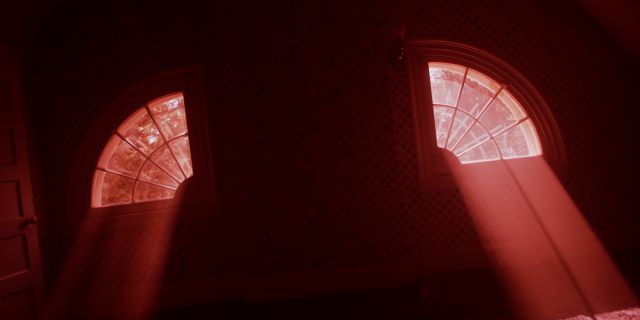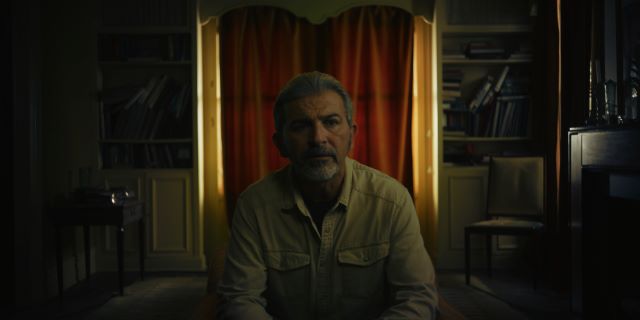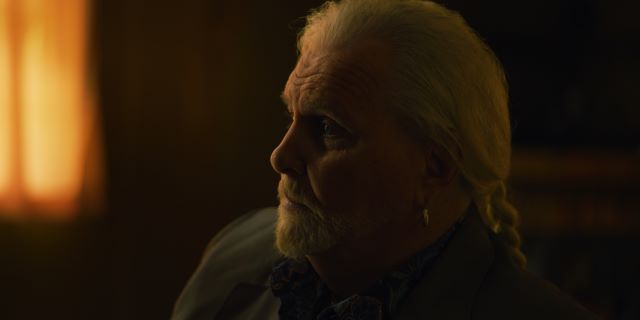
After the first two episodes of Amityville: An Origin Story, I wasn’t sure where it was headed. By the end, I understood why I groan every time I see another Amityville anything. Overkill. In addition to some fantastically inane offerings —including Amityville Clownhouse, Amityville Karen, Amityville in Space, and porn movies— there have been over 30 Amityville-inspired sequels, spin-offs, or whatever you want to call them. Talk about beating a dead horse!
There haven’t been nearly that many documentaries, but there have also been a few of those, including My Amityville Horror (2012) and the Amityville Horror House Shock Docs (2020). The former shared the haunting from Daniel Lutz’s POV. The Shock Doc was heavily biased in favor of both a demonic explanation and Ed and Lorraine Warren’s interpretation of events in the house.
Tubi came out with one, too, Famously Haunted: Amityville (2021). It claimed it aspired to reveal the truth. In its defense, it did a little better job than the other two. But it, too, leaned more towards a “yes, it’s haunted/what a scary house it is” view than presenting all sides and possibilities.
Then there’s the newest incarnation, the MGM+ four-episode docuseries Amityville: An Origin Story.
Humanizing the Amityville Story
I’ll get my biggest criticism out of the way first. I hate the way it ends, which is with a recording from Hans Holzer:
“The house will continue to be a timebomb. Ticking away, ticking away. One fine day, someone will move into that house who has some of the qualities of young Ronald DeFeo, Jr., —and it will start all over again.”
I mean, I get it. Dramatic effect and all that. But I didn’t like the seed that planted. I can just see someone with enough money buying that home the next time it’s for sale, committing murder, and trying to blame it on the alleged dark forces that were lying dormant there. Or maybe not even going that far but claiming outrageous paranormal activity of some sort for another book or movie deal. Either way, it doesn’t sit right.
However, that’s my only criticism of what was otherwise an excellent docuseries. It humanizes the story in a way that’s never been done before and dives deeper than any previous Amityville doc.
Amityville: An Origin Story – The Same, But Different
While it still contains many of the same talking heads as other docs, including Christopher Quaratino (formerly Lutz) and the reporter who broke the original story, Laura DiDio, it presents a lot of fresh faces and never-before-heard voices too.
They speak with friends of Ronald DeFeo, Sr., and his wife, Louise. Friends of Dawn DeFeo. Friends of the Lutzes. Police who investigated the DeFeo murders. Reporters. Scholars. Even John Carpenter!
And there’s lots of footage of interviews with Ronald “Butch” DeFeo, Jr., when he was still alive and behind bars. They even interviewed someone who was in jail with him.
They also address the headaches the house’s fame has caused the town of Amityville in general and the residents of the street the house is on in particular. And then there are the issues it’s caused the house’s owners over the years. Talk about no peace and lots of invasions of privacy.
It made for a super refreshing and incredibly eye-opening docuseries, not to mention a heartbreaking one on many levels. That’s why it should be the last Amityville documentary.


A Definitive Documentary
Sadly, whether there should be one or not, we’ll probably see another Amityville house documentary. However, it’s highly doubtful we’ll see one as exceptionally well produced as An Origin Story. I don’t know what another one could even offer. (Except maybe Missy’s story. I think she’s the only Lutz child that has remained silent about the haunting.)
My fear is that any other future docs will devolve the way sequels to the original Amityville Horror movie have, meaning they’ll get more ludicrous. Especially as people close to the story continue to die off, the answers and truth go with them.
That’s why it wouldn’t surprise me to see future projects take a turn toward the fantastical and unverifiable. Like psychics coming in claiming to channel DeFeo, Jr. or victims from the murders, or even George and Kathy Lutz. Or ghost hunters being allowed to investigate and adamantly reinforcing the demon narrative, which may or may not exist.
Demons are something Amityville: An Origin Story explores but doesn’t sell. In fact, it pretty much annihilates it as it examines all angles of the story, including delving into the backgrounds and dynamics of both the DeFeo and Lutz families.
It’s part true crime in its examination of the DeFeo family murders. Then it explores what led to the Lutzes purchasing the house, their experience in it, and the media and their lawyer’s involvement with both creating and hyping the story.
Again, other docs have covered how people like Hans Holzer and Ed and Lorraine Warren investigated the house and even how Jay Anson ended up writing The Amityville Horror book. Which, let’s explore that really fast…
The Book
I always assumed it had been published as fiction. It wasn’t until Amityville: An Origin Story showed a bestseller list from back when it was released that I realized it had been published as nonfiction.
Anson used tapes George and Kathy Lutz had recorded about their experiences to write the book. But as An Origin Story evolved, it became clear he’d taken some liberties with their accounts. He’d embellished and elaborated on some things that didn’t happen in real life.
Except, the reality of the story is questionable, as a large part was simply conjured up. Seeing how well The Exorcist had done, William Weber, the defense attorney for Ronnie Defeo Jr., had one thing in mind: making money from this story. He approached the Lutzes about a book he was writing and it was from that their story grew. As Weber put it, they fleshed it out over “many bottles of wine.”
But stories within the book weren’t the only exaggerations.
The Photo
There’s a very famous photo taken when the Warrens investigated the house. It shows a little ghostly boy peeking out of a doorway, he’s eyes bright white. It’s easy to see why many believe it’s the ghost of John DeFeo.
To this day, many still believe it’s a real photo of a ghost, even though many others have debunked it. Christopher Quaratino did in An Origin Story too, explaining the boy is wearing a plaid shirt —the exact same shirt worn by Paul Bartz, an investigator who was with the Warrens during their investigation of the house.
In the documentary, they merge Bartz’s face over the “ghost boy” image to show it matches.
But will that finally debunk that piece of proof? Unlikely.
“This has got to be the end.”
At the end of the final episode of Amityville: An Origin Story, former reporter Joel Martin made one of the best statements about why the alleged Amityville haunting made such an impact, and such an enduring one at that.
“This has got to be the end,” he said. “I don’t understand why people…I don’t know why people are so interested in it. I guess because it’s a ghost story, and people love ghost stories. And they want to believe they’re real, and you want to believe there’s something beyond our lives. Something that’s beyond us.”
Did the Lutzes experience something paranormal in the house or just in their minds? Or maybe a bit of both?
It’s not like they didn’t know what had transpired there when they bought the house. They show Kathy explaining they even consulted the kids before buying it, explaining about the murders, to make sure they would be kay moving in.
Then the documentary delved into George and Kathy’s proclivities with transcendental meditation at that time. Combine that with the creepiness of living in such a tragic murder house, and, understandably, ghosts and demonic forces emerged —whether they were real or imagined.
For the Sake of the Lutz Children
But here’s the thing. Christopher Quaratino and his brother and sister were just kids then. No imagination is more potent or powerful than a child’s. So even if what they experienced was a run-of-the-mill trauma haunting caused by the DeFeo family’s murders, it could’ve felt demonic to them. Or no haunting might have happened at all, but on some level, they were creeped out by it all the same.
It really doesn’t matter whether their experiences were real or imagined. That’s how they remember them. As having happened. It’s part of the fabric of their childhoods.
Nothing highlighted that more profoundly than when Christopher spoke of how the family moved to California after the book and movie came out. His classmates figured out who he was on their own due to his name and New York accent. Then he had to live life as the boy from one of the most famous, scariest haunted houses in American history.
But that was on top of dealing with a stepdad who, it turned out, had issues of his own, including not getting along with Christopher.
That’s why this needs to be the end, for the sake of the Lutz children. Yes, they’re adults now. But, again, just because you grow up doesn’t mean you shed your childhood memories, and certainly not traumatic ones. Often you bear those scars for life.
Hopefully, talking about it like Christopher did in An Origin Story has helped him deal with any lingering unresolved issues. And I hope it helps him and his siblings with any additional healing they may need as well.
Because that’s what this docuseries drove home most of all. Real people were involved in a story that just grew more and more sensational. Hearing from people who knew them, both the DeFeos and the Lutzes, brought them to life in a much-needed way. It helped emphasize they weren’t just characters in that story.
Once upon a time, they lived. They existed. They mattered. And they deserve respect and to rest in peace. Hopefully Amityville: An Origin Story can help with that.
Check-In
Did you know the book was published as nonfiction?
Courtney Mroch is a globe-trotting restless spirit who’s both possessed by wanderlust and the spirit of adventure, and obsessed with true crime, horror, the paranormal, and weird days. Perhaps it has something to do with her genes? She is related to occult royalty, after all. Marie Laveau, the famous Voodoo practitioner of New Orleans, is one of her ancestors. (Yes, really! As explained here.) That could also explain her infatuation with skeletons.
Speaking of mystical, to learn how Courtney channeled her battle with cancer to conjure up this site, check out HJ’s Origin Story.

Maybe fiction based on real events, but straight up nonfiction? Hmm. Surely no one believes anymore that the ghost photo is an actual picture of a ghost. I can understand why people would have believed it was a ghost before learning about the plaid shirt thing, though.
Yes! I thought the book was how you put it: fiction based on a true story. I had no idea it was sold as true nonfiction. And all the neighbors and friends they interviewed…it was interesting to see how many said they tried to read the book but couldn’t finish because it was just too over the top nonsensical with some of the claims. I also 100% admit I was one of those who was impressed by that photo. It didn’t seem strike me as authentic that a little boy would look out and stare face-on into a photo, BUT it did look so much like the one son that I was like, “Okay, that could be real…” Until a few years ago when people really started pointing out that it wasn’t and why, and this documentary unequivocally explained that it was faked. Such an insightful, eye-opening, thought-provoking doc on so many levels. As always, sure do appreciate your comments, Vera!